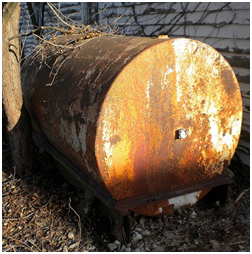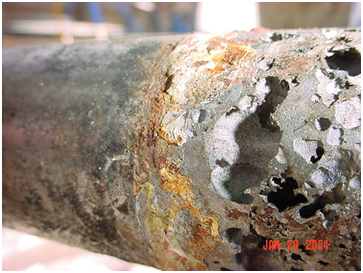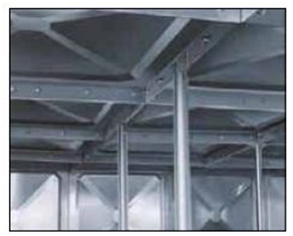Advances in
eISSN: 2373-6402


Reduction of water constructions and installations problems, improvement of construction life, provision, transference, distribution, purification and reservation of water are of the most important matters in urban culture due to importance of drinkable water supply for cities and villages of the country, considering the increase of need in consumption of water supply. One of the basic troubles of industries and consumers in the whole country is maintenance of water infrastructure and constructions which cost a fortune to construct and utilize. Through the stage of utilization, preservation of the facility is very important. Through this presentation we take a look at the subject of corrosion in Water cylinders made of metal, concrete or mixed materials considering past experience. Corrosion is mostly due to an unsuitable environment. Such soluble compounds as sulfur, hydrogen, carbon dioxide etc. in the water accelerates the process of corrosion greatly.
Keywords: amelioration, strengthening (resentencing), corrosion, water cylinder corrosion
Water supplies and their essentials is the key to development and human growth, however, natural disasters and damages due to unsuitable environment reduced utilization of the water supplies. Through this essay, we deliberate the corrosion dilemma and examine efficiency of the preservation procedures in hand based on Water Company experiences.1
Drinkable water cylinders
Water Cylinders which are required to be designed and manufactured due to safety factors for different conditions are produced in different structures due to different applications. Through this study, corrosion in water cylinders made of metal, concrete or mixed materials which are used in water industry of the country is explained. These water cylinders are made of either metal or non-metal (composite) materials or a mixture of both of which, designs are required to be produced requiring the least budget and material, manufacture of such cylinders include complex designs and production processes. Such cylinders must be persistent to static and dynamic charges, exhaustion in different environments and damages.2
All metal water cylinders
This kind of Steel, Aluminum or mixed concrete alloys water cylinders need to pass performance tests however the standards are not set for the type of the alloy and design tensions. These tests are necessary to ensure resistance to corrosion and exhaustion. The safety of the water cylinders is tested and observed by doing destructive and nondestructive experiments such as rigidity test, Hydrostatic pressure test, CrMo determination.3
Hoop wrapped water cylinders
These cylinders are made of Steel or Aluminum or mixed concrete which are strengthen in radius by composite material and ERP or two layer Geo-membranes, Except for the two ends of the water cylinder which are usually made of glass, carbon or Armid fibers with Resin. Composites employed in water cylinders are mostly Epoxy or Resin Isophthallic Polyester.
Fully wrapped water cylinders
This type of water cylinders are made of Steel, Aluminum or Concrete mixtures strengthened by composite fiber on radius and axis. They are lighter than Hoop Wrapped and the two directions strengthening by composite fiber have led this type to take more pressure and charge than Hoop Wrapped cylinders. Moreover, concrete mixture cylinder type is built more persistent due to consideration of different loading for it.4
All composite water cylinders
This type of water cylinders are again strengthened by composite fiber on radius and axis, but it’s different in the material which linear wall is made from, which is Polyethylene. Loading capacity of this type is proportional to its strengthening and it is more persistent to load and pressure in horizontal shape than metal, concrete and not strengthened (Figure 1).5



Figure 1 Effects of P sources and application rates on residual total N in soils after harvest.
Note: P sources ending with 1, 2, 3 and 4 indicates 0, 20, 40 and 60 kg P ha-1 respectively
Ferroconcrete cylinders
This type of water cylinders are made of ferroconcrete. Life of this water cylinder is much more than other types and they work more applicable in south parts of the country. However, they are not applicable in cold regions due to implementation problems.
Stone cylinders
This type was formerly built in regions having no appropriate material, the stone in which the region of building was rich, was convenient. Corrosion of this type highly depended on the kind quality of stone found in the area and materials used.6
Utilization conditions of water cylinders
Utilization conditions of water cylinders are different according to region, weather conditions, water quality, process of building, application situation and loading and unloading conditions.7
Problems due to water quality
Transferring and saving water or any other liquid depends on its quality and combination control. Generally, saving water won’t face any problems as long as it runs in pipelines having specific combinations. Carbon dioxide, Oxygen and Sulfur (H2S) are ingredients responsible for corrosion of cylinders specially uncovered concrete type. Limitations are set about the amount of sulfide hydrogen, the more of this substance, the more corrosion. Effect of water quality and other characteristics are examined separately.
Water: when the wall of the cylinder is exposed to water, it faces problems unless the material is in the category not damaged by water. Corrosion decreases in winter. Still water in pipelines and cylinders increases the possibility of corrosion. Water may cause corrosion and producing base combinations.
Carbon dioxide: carbon dioxide in water increases corrosion in Steel and concrete cylinders.
Pace of corrosion depends on pressure, temperature, the amount of iron carbonate, density and resistance of materials of which the cylinder is made. Corrosion may occur in places where the water is being still and upper parts are safe, however, sometimes corrosion in upper parts is more due to brume or even air.
Hydrated combinations: as the pressure increases in the cylinder, hydrated combinations are produced at above a temperature of 0˚C (meaning this happens less in cold regions). This could lead to blockage of pipes, valves, pressure regulators, evacuation pool, fire valves and safety valves. Therefore, a specific range for amount of water is defined for each cylinder. Density of corrosive combinations in water must be as low as to keep freezing point of the water in the cylinder lower than least freezing point of water in the environment at a pressure of 5centigrade. Practically this means 10 to 50milligrams per cubic meter.8
Hydrogen Sulfide: hydrogen sulfide dissolved in water makes an acidic combination and increases corrosion and frangibility of metal. Experiments suggest that intensity of corrosion depends on the amount of hydrogen in the environment.
Sulfur: due to low dissolvability in water, sulfur doesn’t cause corrosion much.9
Mercaptan: this redolent substance, dissolves at low amount in water, therefore it doesn’t cause corrosion.
Corrosion is one of the most important matters in engineering science that causes many economic, environmental, technical, safety and etc. problems as well as having a noticeable number of industrial studies and projects. Rise of energy supply cost, human resources, high temperature and pressure, and more corrosive and complicated environments in industrial processes led to a progressive increase in economic loss through recent years. Importance of corrosion rises highly when it threatens users’ safety directly through its influences. In service structures such as transferring lines and water cylinders, corrosion leads to utilization life decline and charging high costs.10
Crevice corrosion
The most common corrosion in water cylinders is crevice corrosion. This happens in gaps and crevices in cylinders where corrosive solute stayed long. Crevice corrosion starts where rubber meets metal. No gasket must be placed between holding belts and cylinder where liquid stays.11
Pitting- Pitting happens when a small piece of metal surface is exposed to corrosive environment due to specific fault such as covering failure, and it is corroded intensely. This corrosion is highly focused which leads to a hole in metal or composite. Holes usually advance in the direction of gravity. Piercing is done through and an autocatalytic reaction. Cylinders used must be preserved from corrosive factors which are done by appropriate covering (two-layer Resin or Zeolite covering combined with sea cement).12
Intergranular corrosion
Grain boundaries are energetic areas and they are more active chemically. That is why, when the surface of a metal or combined material is exposed to corrosive material, grain boundaries get corroded faster than grain surface (Figure 2) (Figure 3).

Figure 2 Effects of P sources and application rates on residual total N in soils after harvest.
Note: P sources ending with 1, 2, 3 and 4 indicates 0, 20, 40 and 60 kg P ha-1 respectively

Figure 3 Effects of P sources and application rates on residual total N in soils after harvest.
Note: P sources ending with 1, 2, 3 and 4 indicates 0, 20, 40 and 60 kg P ha-1 respectively
As you know, alloys are of two categories, heterogeneous and homogeneous, homogeneous alloys are more resistant to corrosion since there is no galvanic matter in them. Therefore, in order to produce a homogeneous alloy through stages of cylinder building, elements of which this solid solute is made must be observed (Figure 4) (Figure 5).

Figure 4 Effects of P sources and application rates on residual total N in soils after harvest.
Note: P sources ending with 1, 2, 3 and 4 indicates 0, 20, 40 and 60 kg P ha-1 respectively

Figure 5 Effects of P sources and application rates on residual total N in soils after harvest.
Note: P sources ending with 1, 2, 3 and 4 indicates 0, 20, 40 and 60 kg P ha-1 respectively
Since Steel alloys are used as a material in building water cylinders, in the following an explanation of this resistance mechanism to corrosion of these types of Steel alloys is provided. Chromium (Cr) plays a role of a victim to protect iron from corrosion as a basic base metal. When oxygen rushes to the metal surface, a great amount of iron oxide is made, but since Chromium combines with oxygen more than iron, iron oxide is remotely replaced by chromium oxide so, a sticky layer of chromium on the surface, makes a resistant layer and blocks infiltration of oxygen to the surface of iron oxide, and hereby protects the metal.
Galvanic or two metal corrosion
Difference in electrical potential between two diverse metals which meet each other in spots leads to electron flow between them and leads to galvanic corrosion. Environment factors such as temperature, humidity, and effect of surface, proportion of anode surface to cathode surface effect the pace of corrosion highly.
Metal water cylinder meeting aluminum get corroded less and their lifetime increases by protection of Steel body. This policy also works in concrete cylinders. Material used is to be considered when choosing connectors and parts. Through connecting, it’s suggested to use rubber and polyethylene material instead of gaskets and other metal things in order to reduce corrosion.13
SCC: (Stress Corrosion)
This is a result of tensile stresses, chemical combination of the solute, SCC of corrosive environment on metal simultaneously. Stress and structure of the metal are the important factors in chemical combination of metal or composite. For instance, these stresses may cause compression on one spot and lack of compression on another spot. This leads to a gap, and in that gap, less compressed spots act as appropriate anode for corrosion by environment. While in compressed spots which act as cathode, cannot be protected by acidic rain, since acidic rain is not strong enough for an SCC process.14
Solution
Cylinders covered with glass fibers must not be touching acid. Batteries must not be near cylinders. These batteries can easily be leaned and sulfuric acid spills from them. Moreover, batteries give out sulfuric acid gas which sits on cylinders. Make sure that the batteries of the vehicle are in a safe distance from composite cylinders covered with glass fibers.
Ready-to-use cylinders and their applications
Considering natural water crisis in the country, lack of equality in raining, drought, reduction of water resources, population and usage growth, progress in industry and agriculture, which require great amount of good quality water, great deal of programming and planning, basic managing to decrease over usage and its damages and attending the subject of saving water is highly and definitely needed.
Ready-to-use cylinders’ characteristics
This type of cylinders has many advantages rather than regular cylinders.
Ready-to-use Water cylinders’ applications
Disadvantages of concrete cylinders rather than ready-to-use cylinders
In the argument of these consequences a new instrument for trans-granular pressure corrosion is offered. When instances were distorted within the corrosive surroundings, the tubal rush and the external roughening were perceived to be intensified in the areas of serious deformation. Perceptions also demonstrated that for all the alloys checked, static displacements did not begin chemical offense. It is suggested that when sensitive alloys are subjected to stress corrosion cracking circumferences a mechanically feeble, pitted construction is built along active slip cylinders, and that directorial fracture happens through this rusty substances. The chemical activity of the lapse cylinders, which are trusted to begin the pitting attack, is argued in relation to the kind of surface slip structure found in alloys. The attendance of these accelerates was related with the trans-granular stress corrosion capacity of these alloys. The feasibilities porous metallic structures are survived. Non-disastrous as well as disastrous procedures are explained. Results of the disclosure on the FRP composite and its components, as well as interplay effects develop from FRP composite-concrete bond are explicited and failure mechanisms are precised. It is exhibited that the detriment mechanisms seen are those that would get bigger sorption of water in instances where aqueous dilutions may be offer. Concepts on overall operation are considered.16
The most significant subjects in town civilization because of significance of potable water reserve for towns and small towns of the nation, taking into account the expansion in require of squandering of water stock which are the decrease of water buildings and installations obstacles, recovery of building existence, preparation, conduction, dispensation, refinement and supply of water. In this article we consider the matter of corrosion in water cylinder is produced by the metal, concrete, mixed substances inspecting past trial. Corrosion is often because of the improper surroundings.
One of the most controversial issues in evaluation of cylinders is different kinds of corrosions in it and the ways to fight them. This essay, after examination of different kinds of corrosion in order to prevent from this unwanted phenomenon, suggests that, cylinders covered with glass fibers must not be exposed to acidic substances and combinations. Different experiments such as acidic environment experiment, cylinder under salty water conditions experiment are set, however most of them are presented by other ISO valid standards based on 11439. Evaluating experiments showed that ready-to-use cylinders must pass specific conditions versus regular pressured cylinders.
None.
Author declares there is no conflict of interest.

© . This is an open access article distributed under the terms of the, which permits unrestricted use, distribution, and build upon your work non-commercially.